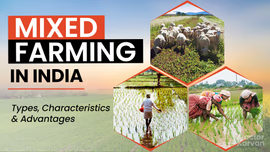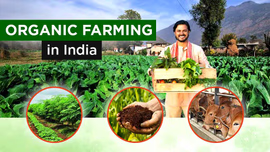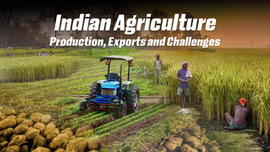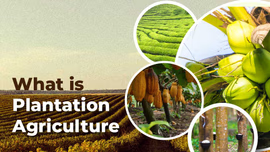Discovering the World of Polyhouse Farming

We are living in a world of modern technological advancements where more and more techniques and innovations are developing each day. Two of such techniques which are gaining popularity are greenhouse farming and polyhouse farming. In this blog, we will explore the world of polyhouse farming in India along with its types, components, variety of crops, advantages etc. Let’s dive into the blog.
Table of Contents
- An Introduction to Polyhouse Farming
- Types of Polyhouses
- Components of Polyhouse
- Variety of Crops grown in Polyhouse Farming
- Difference between Polyhouse Farming and Greenhouse Farming
- Advantages of Polyhouse Farming
- Government Initiatives for Polyhouse Farming
- Polyhouse Farming in the Future
An Introduction to Polyhouse Farming
To know about polyhouse farming, first we need to understand what polyhouse is. Right? Let’s try to understand the meaning of a polyhouse. A polyhouse is a structure made up of polyethylene, a transparent material where plants can be grown in controlled climatic conditions. Polyhouses can be both small and big based on the crop budget and type. Now, we got an idea of polyhouse, let’s understand polyhouse farming in more detail.
Polyhouse farming is a type of greenhouse farming, which was introduced in the early 1980s. In polyhouse farming, crops are grown in a controlled climatic conditions and farmers can easily manage temperature and humidity as per the crop’s requirement. In India, it is widely known technology because of its affordability factor. Polyhouse is of utmost importance because it protects plant from extreme weather conditions like sunlight exposure, winds etc. and helps them to grow efficiently. It is also better than open farming as the crop results is more reliable in this type of farming.
Types of Polyhouses
Polyhouses are mainly divided into three broad categories based on environmental control system, shape and technology. Let’s have a look on each type of polyhouses below.
- Based on Environmental Control System
- Naturally ventilated polyhouse
- Environmental controlled polyhouse
- Based on Shape
- Lean-to
- Even span
- Un even span
- Ridge and furrow
- Saw tooth
- Quonset
- Based on Technology
- Low cost
- Medium cost
- High cost
In India, polyhouses based on environmental control system are more popular than others. Let’s understand each type in detail.
- Naturally Ventilated Polyhouse
A naturally ventilated polyhouse is a basic and traditional type of polyhouse. It has climatic controlled features with drip irrigation systems, foggers, pest control systems, and ventilation control. They completely control the inside climatic conditions and helps crop to grow perfectly.
- Environmental Controlled Polyhouse
Environmental controlled polyhouse, On the other hand, is a modern type of polyhouse. It has additional functional features which can control humidity, temperature etc. It can cultivate the off-season crop with its salient features which makes it a more sophisticated kind of polyhouse.
Components of Polyhouse
- Polyethylene – Polyethylene is the most important component of a polyhouse as most of the polyhouses are made up of transparent polythene, which is tight, cheap and flexible. Polyhouses prevent thermal radiation thus, controls humidity and temperature.
- Heating Systems – Heating systems are used to cover polyhouses with jute clothing during day and night to maintain inner temperature in the absence of sufficient solar energy.
- Cooling Systems – In hot weather conditions, cooling systems are required. The cooling of polyhouse is done by providing adequate ventilation and removing the internal air of polyhouse out of it. It can be natural or by installing high power fans.
- Watering Systems – Water systems are used to test the quality of the water before installing the polyhouse. The water sources should be checked properly. Micro irrigation systems like drip irrigation and sprinklers can be used. A PVC tube, pump and filtration systems are used in drip irrigation.
- Shading Systems - Shading systems are used to protect polyhouse from high light intensity. Shade paints, agro-shade nets or retractable thermal screens are generally used.
- Fertigation – Fertigation is the process of simultaneously applying fertilizers through the irrigation process to meet the specific requirement of the crops. It varies from single broadcasting of fertilisers to the use of soluble grade fertilisers over different operating systems.
- Environmental Control – Polyhouses are protected from temperature, humidity and light by water circulating pump or exhaust fan, incandescent bulbs, and fluorescent tubes.
Varieties of Crops grown in Polyhouse Farming
Polyhouses are used to cultivate off season crops under the synthetic roof. There are varieties of fruits and vegetables along with exotic flowers.
|
Fruits |
Vegetables |
Flowers |
Nursery Plantations |
|
Raspberries |
Chrysanthemum |
Cacti |
|
|
Strawberries |
Tomatoes |
Gerbera |
Colourful Exotic Plants |
|
Muskmelon |
Chillies |
Orchid |
Miniature species |
|
Peach |
English Cucumber |
Rose |
Ornamental indoor plants, etc. |
|
Papaya |
Leafy Vegetables |
Carnation |
|
|
Grapes |
|
|
|
|
Pomegranate |
|
|
|
|
Banana |
|
|
|
These are the most common type of crops cultivated by polyhouses. Make sure to consider market demand, climatic conditions and preferences in selection of the crops.
Difference between Polyhouse Farming and Greenhouse Farming
|
Aspect |
Polyhouse |
Greenhouse |
|
Structure |
metal framework covered with polyethylene or other plastic materials |
galvanized steel frames, featuring glass or polycarbonate panels |
|
Insulation |
Polyethylene covering offers moderate insulation |
Glass or polycarbonate panels offer superior insulation |
|
Light Transmission |
Allows sunlight to enter, but may scatter light |
Provides excellent light transmission, minimizing light scattering and creating optimal conditions for plant photosynthesis |
|
Temperature Control |
Offers limited control over temperature through ventilation and shade nets |
Allows precise temperature control through ventilation, heating systems, and advanced climate control technology
|
|
Durability |
shorter lifespan due to plastic coverings |
Greenhouses tend to be more durable, with glass or polycarbonate panels |
|
Cost |
more cost-effective |
Less cost-effective |
|
Suitable Crops |
Ideal for growing vegetables, flowers, and some fruit crops |
Suitable for a wide range of crops including delicate flowers, high-value crops, and plants that require precise environmental control |
Advantages of Polyhouse Farming
- Controlled climatic conditions such as temperature, heat, wind etc.
- All year-round crops.
- Promote organic farming.
- Less pest and insect attack.
- Reduce the impact of the external climate.
- maximum profit in a minimum area under cultivation.
- High quality produce.
- Ornamental crops can also be grown.
- Increases yield 8 – 10 times.
- Easy fertiliser application.
Government Initiatives for Polyhouse Farming
There are several assistance patterns or subsidies provided to Horticulture Infrastructure (Green house, Poly House, Structure etc.) by the Department of Agriculture & Cooperation, Ministry of Agriculture, Govt. of India.
Under sub schemes of National Horticulture Mission (NHM) and Horticulture Mission for Northeast & Himalayan States (HMNEH) under Mission for Integrated Development of Horticulture (MIDH):
- 50% of cost (15% higher for hilly areas), Rs. 700/- to 825/- per sq. metre assistance has been provided to Protected Cultivation Green House, Fan & Pad System (limited to 4000 sq. metre per beneficiary),
- 50% of cost (15% higher for hilly areas),
- Rs. 422/- to Rs. 530/- per sq. m. Tubular structure,
- Rs. 270/- per sq. m. wooden structure,
- Rs. 225/- per sq. m. Bamboo structure
has been provided to Naturally Ventilated System (Maximum 4000 sq. m per beneficiary),
- 50% of cost (15% higher for hilly areas) up to Rs. 355/- per sq. metre has been given to Shade Net House: Tubular structure (Maximum 1000 sq. m per beneficiary),
- 50% of cost (15% higher for hilly areas), Rs. 180/- and Rs. 246 per sq. metre for bamboo and wooden structures respectively is given to Bamboo & Wooden Structure (Maximum 200 sq. m per beneficiary limited to 5 units),
- 50% of cost (15% higher for hilly areas) up to Rs. 16,000/- hectare is provided to plastic mulch, and
- 50% of cost (15% higher for hilly areas) up to Rs. 300/- per sq. metre has been provided to Plastic Tunnel: (Maximum 1000 sq. m/ beneficiary)
Polyhouse Farming in the Future
Polyhouse farming is gaining wide popularity in India. It is an economical farming system to improve the crop yield and is the perfect replacement for traditional agricultural practices. It can boost the crop yield growth up to 8-10 times which is better than any traditional farming method. This method is also beneficial for the small-scale farmers as they can grow almost any kind of crop whether it is seasonal crop or the exotic off season crop. It is a more efficient farm, using less water and land. It also allows farmers to control the environment, leading to higher yields. In addition, it can protect crops from pests and diseases and provide a stable source of income. Hence, polyhouse farming will remain beneficial for the farmers in the coming years.
Frequently Asked Questions On Discovering the World of Polyhouse Farming
1. What is polyhouse farming?
Polyhouse farming is a sophisticated farming where crops are grown in controlled, indoor environments. These environments are typically made up of plastic or metal frames with transparent walls and roofs.
2. Is polyhouse farming profitable?
Yes, polyhouse farming is profitable because it is cost effective.
3. Which crop is best for polyhouses?
Raspberries, Tomatoes, Capsicum and cacti are some of the crops that are best suitable for polyhouses.
4. What is the subsidy for polyhouse?
The subsidy for polyhouse is 50% of cost under Mission for Integrated Development of Horticulture (MIDH).
5. What are the challenges in polyhouse farming?
High initial investment and energy consumption are the major challenges in polyhouse farming.
6. What are the advantages of polyhouse?
Polyhouse farming increases yield 8 - 10 times as compared to any other kind of farming.


Related Blogs












